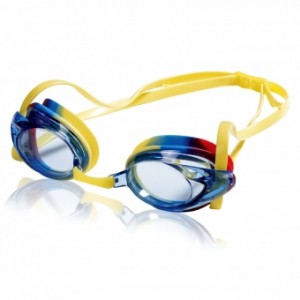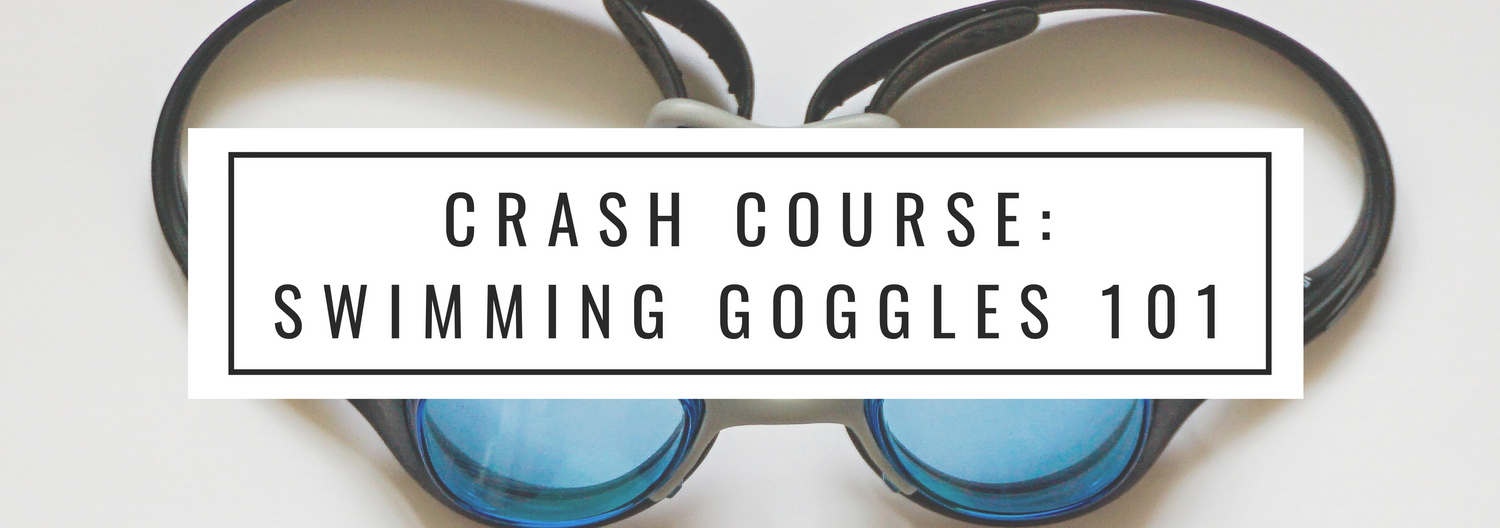Today there are many choices in swim goggles, from streamlined Swedish goggles to almost snorkel worthy swim masks. Goggles differ in frame type, strap configuration, lens color, and lens material. The most important considerations when choosing goggles is to get a pair that protect your eyes, fit right and match your style!
Frame Type
Swedish or Competition Goggles

via Swimoutlet.com
They are a favorite with elite and competition swimmers due to their sleek hydrodynamic design. Swedish goggles have a low profile, no gaskets (they sit flush in your eye socket) and are shipped unassembled.
You’ll need a pair of nimble fingers and good instruction to assemble them, but the resulting pair is custom fit to you.
Usually under US $5, they are widely available and easy to find. They are not the most comfortable goggles for everyday practice,however, so many swimmers use these only for competitions.
Classic Goggles

Speedo Kids’ Vanquisher, image via Amazon.com
Today most of the gaskets are silicone, although you can still find foam ones if you look around. These goggles are more comfortable than Swedish goggles, are the most common type of goggle, and come in endless shapes and sizes.
Swim Masks

Speedo Adult Recreation Dive Mask via Amazon.com
Swim masks are extremely popular with kids (and their parents) because even small children can put them on by themselves. The larger masks are more likely than goggles to be dislodged by diving and flip-turns.
Strap Configuration
Straps tend to come in one of three configurations. You can get a simple strap, a long split strap with one large split (effectively acting like two straps) and a split strap with a two holes in the back (effectively creating a wide, but still a single strap). The single strap is easiest to put on, the long split strap the most difficult. The long split strap is the most secure, the single the least. As you would expect, the split strap with two holes falls in the middle.
Lens color
Lenses are colored for different light conditions. You can also get different coatings and even prescription lenses.
Amber
|
Did you know the invention of the swimming goggle goes back to before 1300 B.C., when Persian divers used a type of eyewear made from polished tortoise shells to see under the water? |
Amber lenses provide excellent vision in both high and low light environments. In low light (indoor swimming pool etc) amber lenses amplify the light, meaning clearer vision in the water. In high light levels (bright sunshine, outdoors etc) they reduce glare which also helps to provide better vision and means you won’t have to squint your eyes so much. A good multipurpose lens color.
Clear
For indoor swimming the most common and effective lens “color” is clear. Clear lenses are also good for night swimming outdoors or in low light conditions.
Blue / Violet Lens
These colors are designed to allow a moderate level of light into the eye but they still provide some protection from glare. It’s a practical color for conditions that might change or you’re unsure of what they will be like. Ideal for everyday events and training.
Smoke or Grey
|
Did you know that the earliest “modern” goggles were held on with window putty? |
The sun glasses of goggles. They will protect your eyes from UV lights and cut through glare. Invest in these if you will be lots of outdoor swimming. Dark lenses provide protection from high light levels. Ideal for swimming out in the sun.
Mirrored
Mirrored lenses take it a step further than sunglass like tinted goggles. They reflect light away from the eyes. They are popular with competitive swimmers and have a certain intimidation factor. Used in very bright conditions or in competitions.
Lens Material
Anti-Fog
This is typically a thin layer of anti-fog chemical applied to the inside of the lens. Over time it can wear away and will need to be reapplied with one of the many anti-fog products on the market such as Barracuda, Speedo, or Aqua Sphere anti-fog. To make the coating last longer, you should never rub or scrub the inside of the lenses.
Prescription
| Did you know goggles were banned from the Olympics until 1976? |
You can easily find goggles now that take prescription lenses. They are not terribly expensive, but it can be tricky to figure out how to order the right lens. Speedo, Barracuda, Tusa-View and AquaSphere all manufacture prescription goggles. Some models are preconfigured as a single diopter strength, the same for both eyes, such as the Barracuda H2Rx.
Others can be configured with replacement lenses that allow you to choose a different diopter for each eye. An example is the Aqua Sphere Eagle where you buy the frame and then two individual replacement lenses with the chosen diopter, one for each eye. Some brands support up to a -9.0 prescription. You want to round down to the next number when choosing; so if you were a -4.8 you would choose a -4.5 rather than a -5.0.
Polycarbonate
Polycarbonate plastic is strong and resists cracking. It comes in a variety of tints and supports UV protection and anti-fog. Most swim goggle are made of plastic, but there is a huge difference in quality. Generally, you’ll get what you pay for.
Optical Grade
This is a high grade plastic that’s used in the construction of prescription glasses. It’s lightweight, scratch resistant and has less distortion than a cheaper lens.



Leave a comment
All comments are moderated before being published.
This site is protected by hCaptcha and the hCaptcha Privacy Policy and Terms of Service apply.